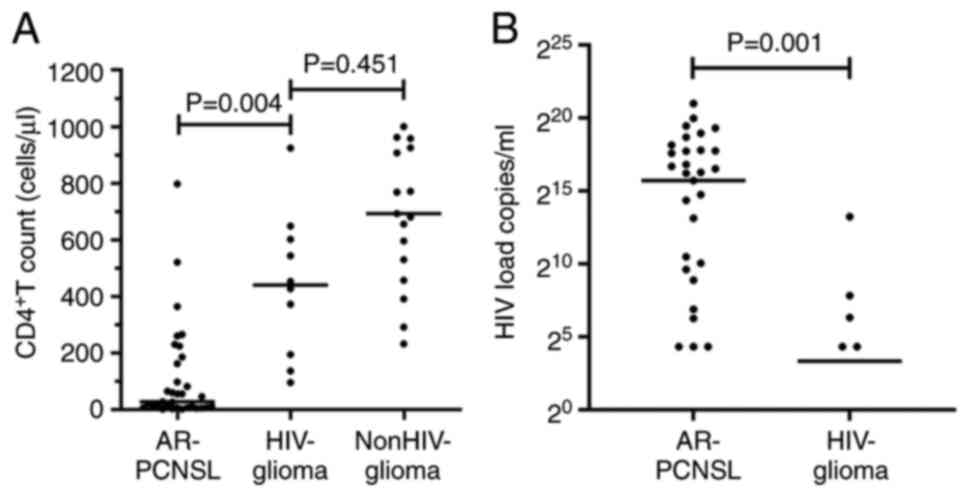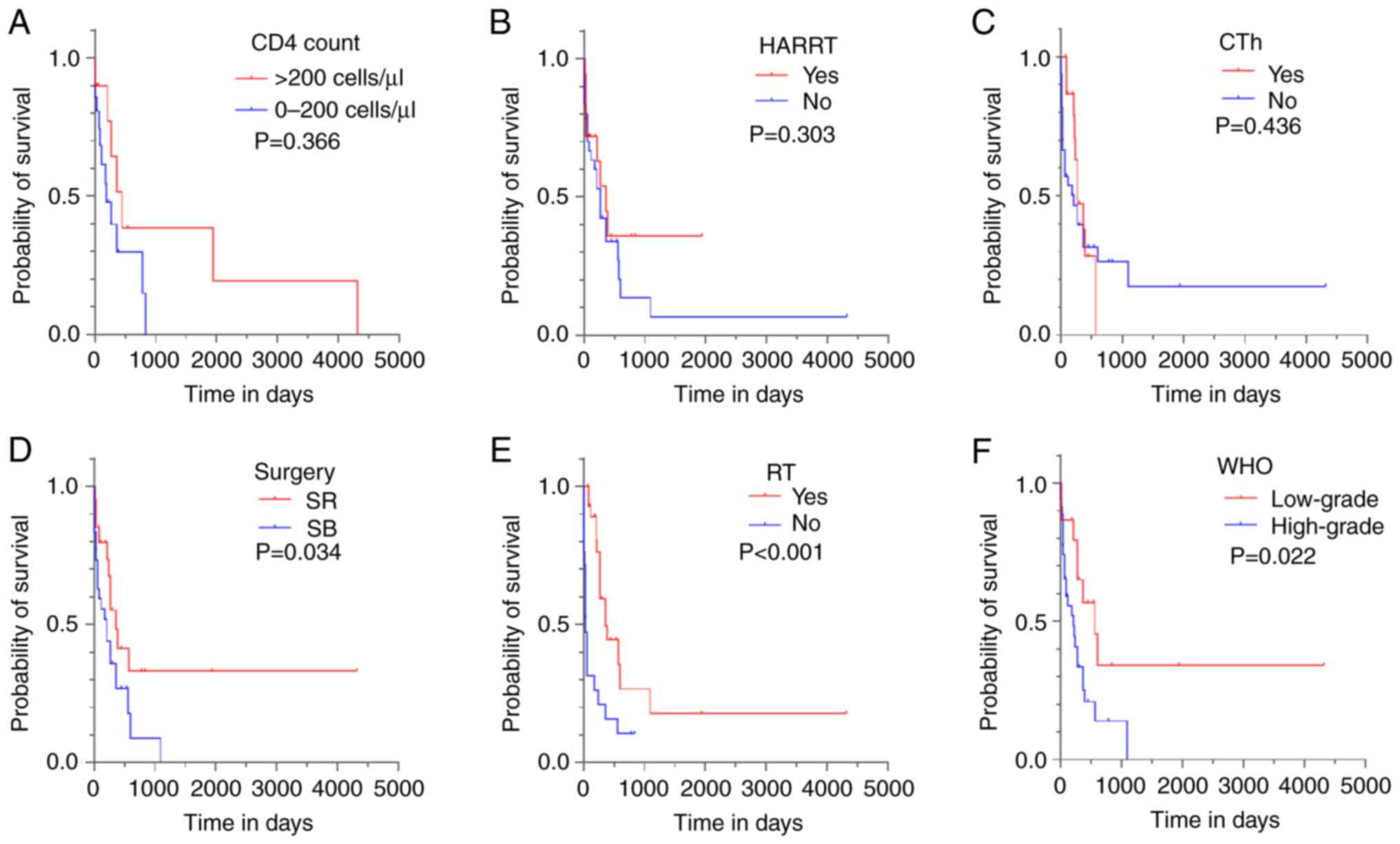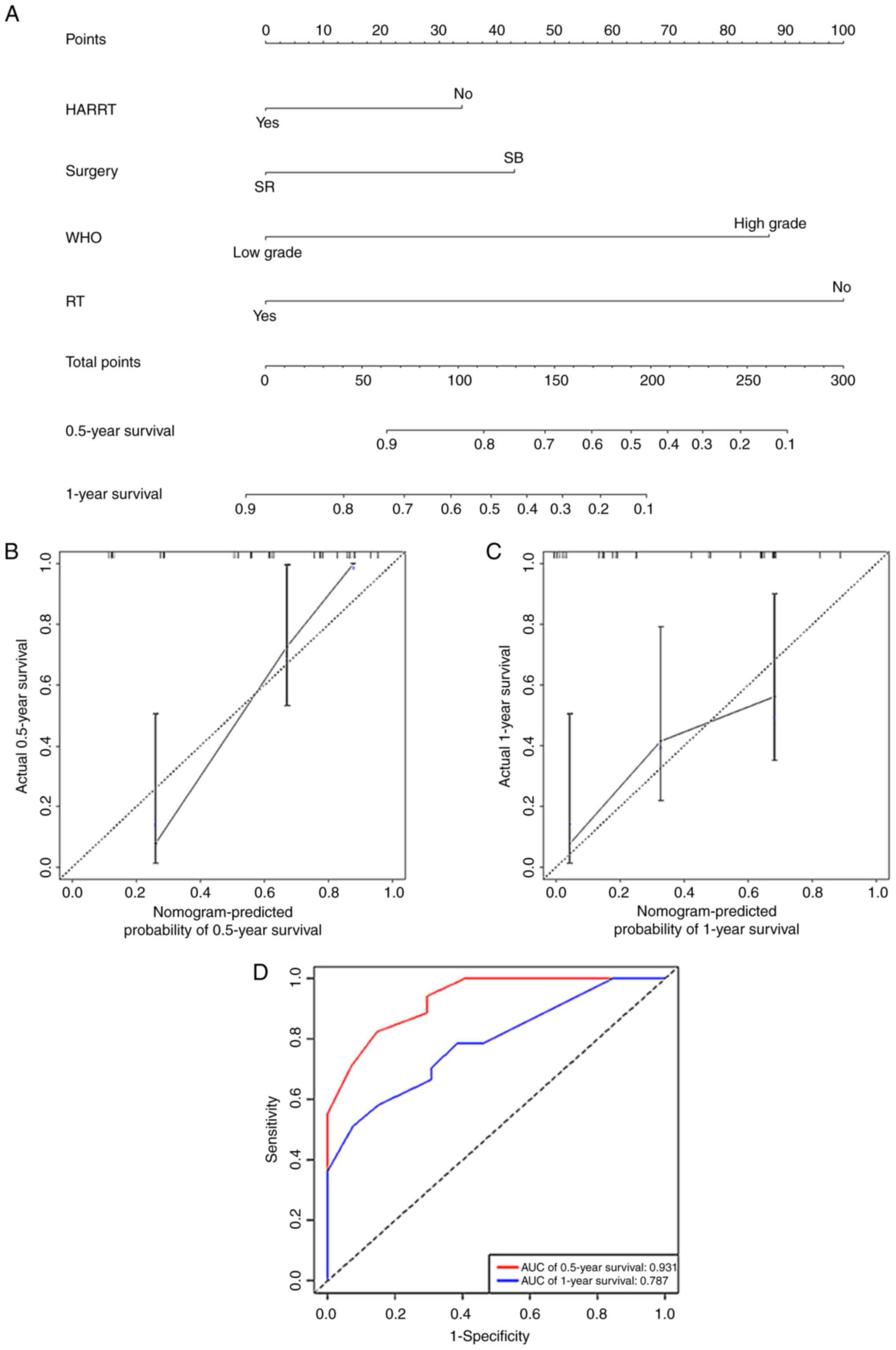|
1
|
Chamberlain MC: Gliomas in patients with
acquired immune deficiency syndrome. Cancer. 74:1912–1914.
1994.PubMed/NCBI View Article : Google Scholar
|
|
2
|
Engels EA, Pfeiffer RM, Goedert JJ, Virgo
P, McNeel TS, Scoppa SM and Biggar RJ: HIV/AIDS Cancer Match Study.
Trends in cancer risk among people with AIDS in the United States
1980-2002. AIDS. 20:1645–1654. 2006.PubMed/NCBI View Article : Google Scholar
|
|
3
|
Moulignier A, Mikol J, Pialoux G,
Eliaszewicz M, Thurel C and Thiebaut JB: Cerebral glial tumors and
human immunodeficiency virus-1 infection. More than a coincidental
association. Cancer. 74:686–692. 1994.PubMed/NCBI View Article : Google Scholar
|
|
4
|
Tacconi L, Stapleton S, Signorelli F and
Thomas DG: Acquired immune deficiency syndrome (AIDS) and cerebral
astrocytoma. Clin Neurol Neurosurg. 98:149–151. 1996.PubMed/NCBI View Article : Google Scholar
|
|
5
|
Blumenthal DT, Raizer JJ, Rosenblum MK,
Bilsky MH, Hariharan S and Abrey LE: Primary intracranial neoplasms
in patients with HIV. Neurology. 52:1648–1651. 1999.PubMed/NCBI View Article : Google Scholar
|
|
6
|
Mendez Valdez MJ, Lu VM, Kim E, Rivas SR,
Govindarajan V, Ivan M, Komotar R, Nath A, Heiss JD and Shah AH:
Glioblastoma multiforme in patients with human immunodeficiency
virus: An integrated review and analysis. J Neurooncol.
159:571–579. 2022.PubMed/NCBI View Article : Google Scholar
|
|
7
|
Jiang T, Nam DH, Ram Z, Poon WS, Wang J,
Boldbaatar D, Mao Y, Ma W, Mao Q, You Y, et al: Clinical practice
guidelines for the management of adult diffuse gliomas. Cancer
Lett. 499:60–72. 2021.PubMed/NCBI View Article : Google Scholar
|
|
8
|
Gasnault J, Roux FX and Vedrenne C:
Cerebral astrocytoma in association with HIV infection. J Neurol
Neurosurg Psychiatry. 51:422–424. 1988.PubMed/NCBI View Article : Google Scholar
|
|
9
|
Carrana EJ, Rossitch E, Moore MR and
Funkenstein HH: Anaplastic astrocytoma in association with human
immunodeficiency virus type 1 infection. Am J Emerg Med. 8:565–567.
1990.PubMed/NCBI View Article : Google Scholar
|
|
10
|
Ho KL, Gottlieb C and Zarbo RJ:
Cytomegalovirus infection of cerebral astrocytoma in an AIDS
patient. Clin Neuropathol. 10:127–133. 1991.PubMed/NCBI
|
|
11
|
Kasantikul V, Kaoroptham S and Hanvanich
M: Acquired immunodeficiency syndrome associated with cerebral
astrocytoma. Clin Neuropathol. 11:25–27. 1992.PubMed/NCBI
|
|
12
|
Chappell ET, Guthrie BL and Orenstein J:
The role of stereotactic biopsy in the management of HIV-related
focal brain lesions. Neurosurgery. 30:825–829. 1992.PubMed/NCBI View Article : Google Scholar
|
|
13
|
Gervasoni C, Ridolfo AL, Rocca A, Vago L
and d'Arminio Monforte A: Cerebral astrocytoma in HIV-infected
patients. AIDS. 9:403–404. 1995.PubMed/NCBI
|
|
14
|
Neal JW, Llewelyn MB, Morrison HL, Jasani
B and Borysiewicz LK: A malignant astrocytoma in a patient with
AIDS: A possible association between astrocytomas and HIV
infection. J Infect. 33:159–162. 1996.PubMed/NCBI View Article : Google Scholar
|
|
15
|
d'Arminio Monforte A, Cinque P, Vago L,
Rocca A, Castagna A, Gervasoni C, Terreni MR, Novati R, Gori A,
Lazzarin A and Moroni M: A comparison of brain biopsy and CSF-PCR
in the diagnosis of CNS lesions in AIDS patients. J Neurol.
244:35–39. 1997.PubMed/NCBI View Article : Google Scholar
|
|
16
|
Vannemreddy PS, Fowler M, Polin RS, Todd
JR and Nanda A: Glioblastoma multiforme in a case of acquired
immunodeficiency syndrome: Investigation a possible oncogenic
influence of human immunodeficiency virus on glial cells. Case
report and review of the literature. J Neurosurg. 92:161–164.
2000.PubMed/NCBI View Article : Google Scholar
|
|
17
|
Wolff R, Zimmermann M, Marquardt G,
Lanfermann H, Nafe R and Seifert V: Glioblastoma multiforme of the
brain stem in a patient with acquired immunodeficiency syndrome.
Acta Neurochir (Wien). 144:941–944; discussion 944-5.
2002.PubMed/NCBI View Article : Google Scholar
|
|
18
|
Corti ME, Yampolsky C, Metta H, Valerga M,
Sevlever G and Capizzano A: Oligodendroglioma in a patient with
AIDS: Case report and review of the literature. Rev Inst Med Trop
Sao Paulo. 46:195–197. 2004.PubMed/NCBI View Article : Google Scholar
|
|
19
|
Hall JR and Short SC: Management of
glioblastoma multiforme in HIV patients: A case series and review
of published studies. Clin Oncol (R Coll Radiol). 21:591–597.
2009.PubMed/NCBI View Article : Google Scholar
|
|
20
|
Chaudhry NS, Ahmad FU, Blieden C and
Benveniste RJ: Brainstem anaplastic glioma in patients with AIDS: A
case report and review of the literature. BMJ Case Rep.
2013(bcr2012008384)2013.PubMed/NCBI View Article : Google Scholar
|
|
21
|
Brassesco MS, Darrigo LG Jr, Valera ET,
Oliveira RS, Yamamoto YA, de Castro Barros MV and Tone LG:
Giant-cell glioblastoma of childhood associated with HIV-1 and JC
virus coinfection. Childs Nerv Syst. 29:1387–1390. 2013.PubMed/NCBI View Article : Google Scholar
|
|
22
|
Oliveira VC, Gomes T, Ferreira LC, Damian
MM, Silva VM, Araújo JR, Safe IP and Ramasawmy R: Glioblastoma
multiforme in an HIV-Infected patient: An unexpected diagnosis. J
Int Assoc Provid AIDS Care. 13:411–413. 2014.PubMed/NCBI View Article : Google Scholar
|
|
23
|
Wang T, Gao T, Niu X, Xing X, Yang Y, Liu
Y and Mao Q: Clinical characteristics and prognostic analysis of
glioma in human immunodeficiency virus-infected patients. World
Neurosurg. 114:e218–e223. 2018.PubMed/NCBI View Article : Google Scholar
|
|
24
|
Jokonya L, Musara A, Esene IN, Kabulo KDM,
Kabeya CM and Kalangu KKN: Prevalence of human immunodeficiency
virus infection in brain glioma patients: Is the virus protective
from gliomas? Surg Neurol Int. 9(103)2018.PubMed/NCBI View Article : Google Scholar
|
|
25
|
Simpson DM and Tagliati M: Neurologic
manifestations of HIV infection. Ann Intern Med. 121:769–785.
1994.PubMed/NCBI View Article : Google Scholar
|
|
26
|
GBD 2017 HIV collaborators: Global,
regional, and national incidence, prevalence, and mortality of HIV,
1980-2017, and forecasts to. 2030, for 195 countries and
territories: A systematic analysis for the Global Burden of
Diseases, Injuries, and Risk Factors Study 2017. Lancet. HIV 6:
e831-e859, 2019.
|
|
27
|
Ostrom QT, Cote DJ, Ascha M, Kruchko C and
Barnholtz-Sloan JS: Adult glioma incidence and survival by race or
ethnicity in the United States From 2000 to 2014. JAMA Oncol.
4:1254–1262. 2018.PubMed/NCBI View Article : Google Scholar
|
|
28
|
Liu S, Zhang C, Maimela NR, Yang L, Zhang
Z, Ping Y, Huang L and Zhang Y: Molecular and clinical
characterization of CD163 expression via large-scale analysis in
glioma. Oncoimmunology. 8(1601478)2019.PubMed/NCBI View Article : Google Scholar
|
|
29
|
Xu L, Liu Z, Wang H, Lu J, Xu J, Meng Y,
Huang K and Liu B: SESN2 could be a potential marker for diagnosis
and prognosis in glioma. Genes (Basel). 14(701)2023.PubMed/NCBI View Article : Google Scholar
|
|
30
|
Zhang M, Cheng Y, Xue Z, Sun Q and Zhang
J: A novel pyroptosis-related gene signature predicts the prognosis
of glioma through immune infiltration. BMC Cancer.
21(1311)2021.PubMed/NCBI View Article : Google Scholar
|
|
31
|
Hajjar M, Lacoste D, Brossard G, Morlat P,
Dupon M, Salmi LR and Dabis F: Non-acquired immune deficiency
syndrome-defining malignancies in a hospital-based cohort of human
immunodeficiency virus-infected patients: Bordeaux, France,
1985-1991. Groupe d'Epidémiologie Clinique du SIDA en Aquitaine. J
Natl Cancer Inst. 84:1593–1595. 1992.PubMed/NCBI View Article : Google Scholar
|
|
32
|
Rabkin CS and Blattner WA: HIV infection
and cancers other than non-Hodgkin lymphoma and Kaposi's sarcoma.
Cancer Surv. 10:151–160. 1991.PubMed/NCBI
|
|
33
|
Pore N, Gupta AK, Cerniglia GJ and Maity
A: HIV protease inhibitors decrease VEGF/HIF-1alpha expression and
angiogenesis in glioblastoma cells. Neoplasia. 8:889–895.
2006.PubMed/NCBI View Article : Google Scholar
|


















